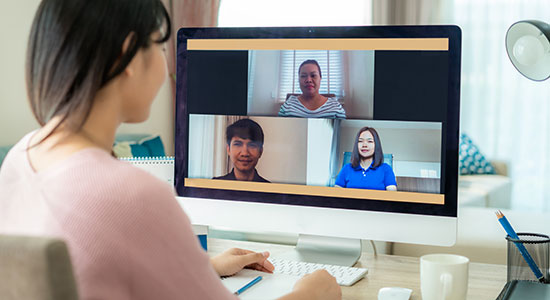
April 15, 2020 – No matter how much coronavirus is turning our world upside down and isolating us from our colleagues and clients, people are still enmeshed in legal disputes and they still need to find a way out of them.
Mediation remains an essential function of trial lawyers and litigators and an essential tool for serving clients. Video mediation has become the name of the game. Here are a few suggestions for upping your video mediation game:
Get Comfortable with the Technology; Help the Client Get Comfortable
As in the courtroom, the more you look like a pro, the more persuasive you will appear. Until you have considerable experience with video conference platforms (Zoom, Microsoft Teams, Go2Meeting, Skype, etc.), it pays to practice, to raise your comfort level and to be prepared for simple troubleshooting.
Before the mediation, try out the technology. Try it out on your staff or colleagues or family first. Ask them to screen shot what they see, so you can see what your client is seeing.
Then try a virtual cup of coffee with your client. Pick a time just to talk and practice. Make sure you and the client have downloaded the software and are comfortable following the instructions to join the meeting. Mouse around the screen together and see how all the various buttons work, especially the mute (and unmute). Offer each other constructive criticism on how you look and sound coming across the screen and whether the lighting and background look professional or tend to distract.
Have a Plan B, Be Prepared to Repeat
Internet connections fail, bandwidth fluctuates, and the cable can go out. One experienced mediator who regularly employs video mediation, Retired Federal Magistrate Judge David Jones, recommends: “plan for a platform failure” and have a Plan B: before you start the video conference, remind participants how to rejoin the meeting if they lose the connection.
Also, exchange cell phone numbers for all the participants and have a teleconference line available. If you are underway and encounter trouble, you may have established enough rapport by video to conclude the mediation entirely by telephone.
Also, be on the look-out for freeze-frame. If a participant’s face looks frozen, it’s possible that the participant’s connection is too weak, or yours is.
Do a quick check to make sure everyone can still hear and see you. “Nothing is worse,” Judge Jones says, “than figuring out that the folks you've been talking at for the last ten minutes didn't hear a thing you said because they lost the connection.”
Prepare for Your Close-Up, Stay in the Frame
Video doesn’t replicate a face-to-face conversation perfectly, but you can take steps to reap much of the same effect.
Position your device so that you are looking into it at eye level, not as if looking down a well, with your viewers looking at your chin and up your nose.
It might seem uncomfortable at first, but get close to your camera, so your face fills most of the screen. In person, our counterparts pick up visual cues from our faces – about patience, about encouragement, about empathy, about concern, that wink, that smile, that raised eyebrow, etc. Those cues won't come across if you are too far from the camera.
To keep that personal connection, stay in the frame. As you look around your workspace at our notes and other screens and the like, think of how that looks to others. Think about whether you have left the screen altogether. When a point needs to be made directly and personally, find the camera lens and look directly into it. Think of how a movie director or fashion photographer might coach you to connect with your subject.
Slow Down, Take Breaks
Discussion by video seems more taxing than in person, and seems to require more concentration, especially when multiple parties are participating.
Judge Jones offers this counsel: “We need to slow down and make sure we’re not talking over people. Talk in shorter bursts, giving more opportunities for interaction, just to make sure the communication lines are working.”
Also, take breaks regularly, so participants can give their eyes a rest from the screen and catch their breath.
Breakout Rooms
If you and your mediator have a choice of video conference platforms, choose a platform that allows the mediator to create separate channels for separate parties.
For example, Zoom offers “breakout rooms,” where a client and lawyer can talk to each other without other parties and their lawyers hearing or seeing them. The mediator can join and leave the conversation, just like in an in-person mediation.
Indeed, a mediator who is proficient at managing breakout rooms can do the parties a real favor. During that time in the breakout room, an attorney and client who may not yet have had the opportunity to meet face-to-face may be having their first real opportunity for a heart-to-heart conversation about the case.
Know Where to Find the Mute Button
If you use Zoom, here's a simple trick you may not have learned yet: The host can mute all the participants, but then invite them to temporarily unmute themselves by holding down the space bar, kind of like a button on a microphone.
This is particularly helpful during joint sessions, making participants more deliberate and careful about speaking up and deciding when they need to interrupt. (Caution, however: this tip works only for participants who are working from a device with a keyboard, not a phone, and not most tablets.)
Sharing Documents During the Video Conference
Some video conference platforms, such as Zoom and Microsoft Teams, offer a “screen sharing” feature. The software permits a participant to show, in place of their video feed, what that participant can see elsewhere on his or her computer.
This feature can be used to show a document or a picture. It can be used to mark-up documents or manipulate entries in a spreadsheet.
Some platforms allow the document to be downloaded by the other participants. Think about how this can be used for finalizing settlement terms or contract language. A party can upload and share a signed document as well.
Is Your Virtual Background Too Cute?
Some video conference platforms offer an option to display a “virtual” background, instead of what the camera actually sees behind you.
The technology works like a television green screen, the way a weather map is displayed behind a meteorologist. It’s a useful feature if your background is distracting or if the image you choose will help set a certain mood.
But if the color of your skin or your clothes contrasts too little with the predominant color of your background, only parts of you may appear on screen, or you may appear to ghost in and out of the background. (For a preview, just Google “green screen fails.”)
Blurring the background may be the simplest and best option to avoid distraction, but this feature is not available on all platforms.
Conclusion
Lawyers, mediators and judges are constantly learning how to apply new technology to help them help their clients and constituents. With a little patience and some help from colleagues, everyone can learn to resolve disputes remotely.
Tips to Maximize Your Internet Broadband
 The Federal Communications Commission (FCC) recently published updated Broadband Speed and Household Broadband guides. Simply put, as the number of household users and usage increases, so does the need for higher megabits per second (Mbps) of broadband speed. Below you’ll find some tips for maximizing and increasing your broadband speed.
The Federal Communications Commission (FCC) recently published updated Broadband Speed and Household Broadband guides. Simply put, as the number of household users and usage increases, so does the need for higher megabits per second (Mbps) of broadband speed. Below you’ll find some tips for maximizing and increasing your broadband speed.
-
Contact your internet service provider to test and/or upgrade your broadband speed. The FCC recommends at least 25 Mbps broadband speed for high usage from two users or devices at a time.
-
If your cellular data plan has unlimited data, consider having other members of your household use cellular data only during periods of high demand.
-
Switch video streaming services from high definition video output to standard definition video output.
-
Limit online gaming and streaming service usage.
-
Password protect your router to stop unauthorized use from others.
-
Connect your device directly to your router versus using a wireless connection.
-
Consider temporarily purchasing and utilizing wireless hotspots.
-
Limit the number of devices that can connect to your router during periods of high demand.
Source: Christopher Shattuck, State Bar of Wisconsin Practice Management Advisor (Practice 411™)
